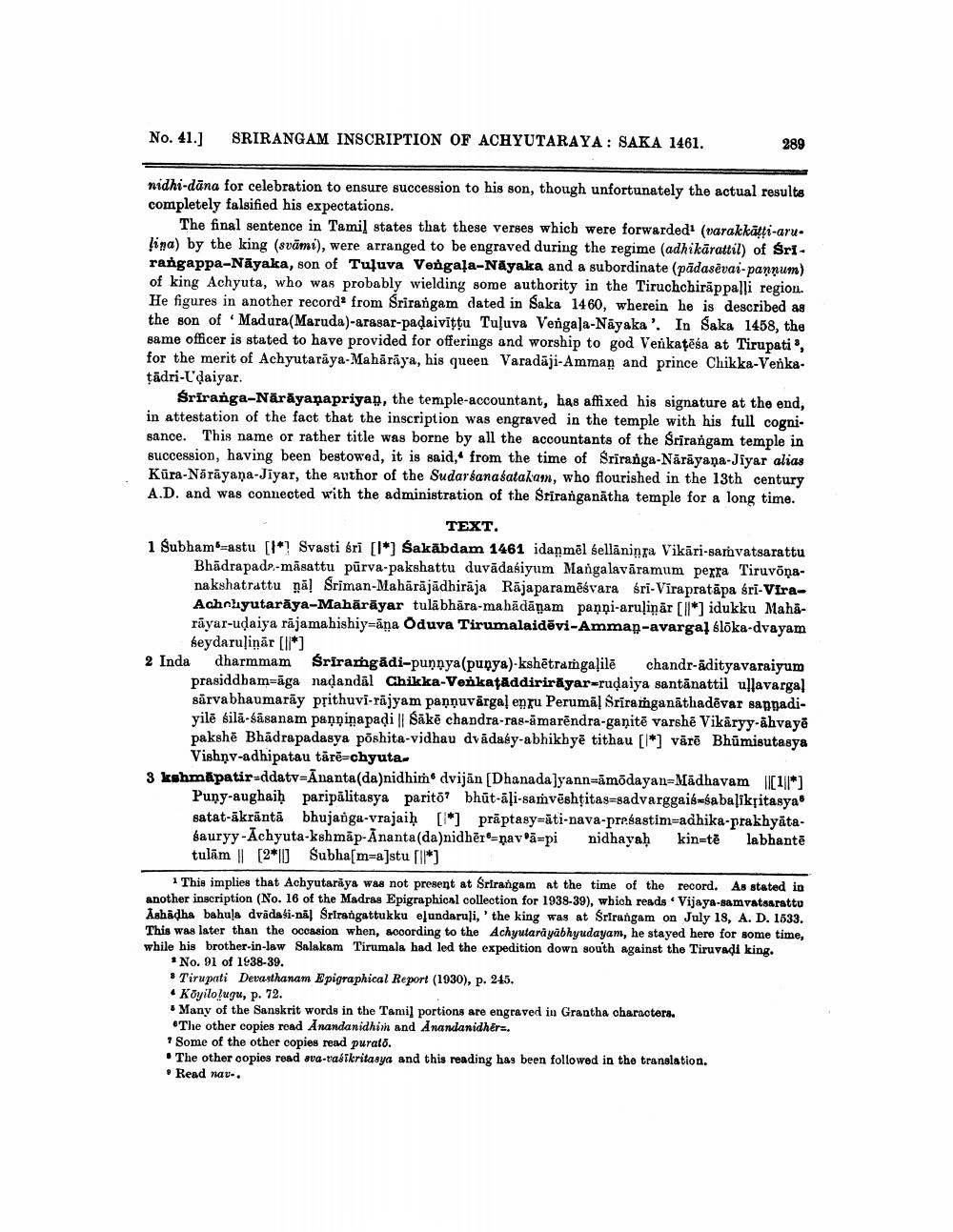________________
No. 41.]
SRIRANGAM INSCRIPTION OF ACHYUTARAYA: SAKA 1461.
nidhi-dāna for celebration to ensure succession to his son, though unfortunately the actual results completely falsified his expectations.
The final sentence in Tamil states that these verses which were forwarded1 (varakkaṭṭi-arulina) by the king (svami), were arranged to be engraved during the regime (adhikarattil) of Srirangappa-Nayaka, son of Tuļuva Vengala-Nayaka and a subordinate (pädasevai-pannum) of king Achyuta, who was probably wielding some authority in the Tiruchchirappalli region. He figures in another record from Srirangam dated in Saka 1460, wherein he is described as the son of Madura (Maruda)-arasar-padaiviṭṭu Tuluva Vengala-Nayaka'. In Saka 1458, the same officer is stated to have provided for offerings and worship to god Venkatesa at Tirupati, for the merit of Achyutaraya-Mahārāya, his queen Varadāji-Amman and prince Chikka-Venkaidri-daiyar
289
Sriranga-Nārāyanapriyan, the temple-accountant, has affixed his signature at the end, in attestation of the fact that the inscription was engraved in the temple with his full cognisance. This name or rather title was borne by all the accountants of the Srirangam temple in succession, having been bestowed, it is said, from the time of Sriranga-Narayana-Jiyar alias Kura-Narayana-Jiyar, the author of the Sudarsanasatakam, who flourished in the 13th century A.D. and was connected with the administration of the Sriranganatha temple for a long time.
TEXT.
1 Subham-astu [*] Svasti śrī [*] Sakabdam 1461 idanmel selläninga Vikari-samvatsarattu Bhadrapade-masattu pūrva-pakshattu duvadasiyum Mangalavaramum perra Tiruvonanakshatrattu nä] Sriman-Mahārājādhirāja Rājaparamēśvara śri-Virapratāpa śri-ViraAchchyutaraya-Mahārāyar tulabhāra-mahādāņam panni-arulinär [*] idukku Maharayar-udaiya rajamahishiy-ana Oduva Tirumalaidēvi-Ammap-avargal ślōka-dvayam Seydarulinar [*]
2 Inda
dharmmam Srirazhgadi-punnya(pugya)-kshetrazhgalālē chandr-adityavaraiyum prasiddham-aga naḍandal Chikka-Venkataddirirāyar-rudaiya santanattil ullavargal sarvabhaumaray prithuvi-rajyam pannuvargal enru Perumal Sriramganathadevar sannadiyilē sila-sasanam panninapadi || Sake chandra-ras-amarendra-ganite varshē Vikäryy-ahvayê pakshe Bhadrapadasya poshita-vidhau dvadasy-abhikhye tithau [*] varē Bhumisutasya Vishay-adhipatau tarë-chyuta.
3 kahmäpatir ddatv-Ananta(da)nidhirh dvijän [Dhanada lyann-ämödayan-Madhavam [1] Puny-aughaib paripálitasya parita bhût-ali-samviahtitas-sadvarggail-sabakitanya satat-ākrāntā bhujanga-vrajaiḥ [*] praptasy-ati-nava-presastim-adhika-prakhyātasauryy-Achyuta-kshmap-Ananta (da)nidher-pava-pi nidhayab
kin-tě labhantē
tulam || [2] Subha[m=a]stu [*]
1 This implies that Achyutaraya was not present at Srirangam at the time of the record. As stated in another inscription (No. 16 of the Madras Epigraphical collection for 1938-39), which reads Vijaya-samvatsarattu Ashadha bahula dvadasi-nal Srirangattukku elundaruli,' the king was at Srirangam on July 18, A. D. 1533. This was later than the occasion when, according to the Achyutarayabhyudayam, he stayed here for some time, while his brother-in-law Salakam Tirumala had led the expedition down south against the Tiruvadi king.
No. 91 of 1938-39.
Tirupati Devasthanam Epigraphical Report (1930), p. 245.
Kōyilolugu, p. 72.
Many of the Sanskrit words in the Tamil portions are engraved in Grantha characters.
The other copies read Anandanidhim and Anandanidhër-.
Some of the other copies read purato.
The other copies read ava-vasikritasya and this reading has been followed in the translation. • Read nav..




